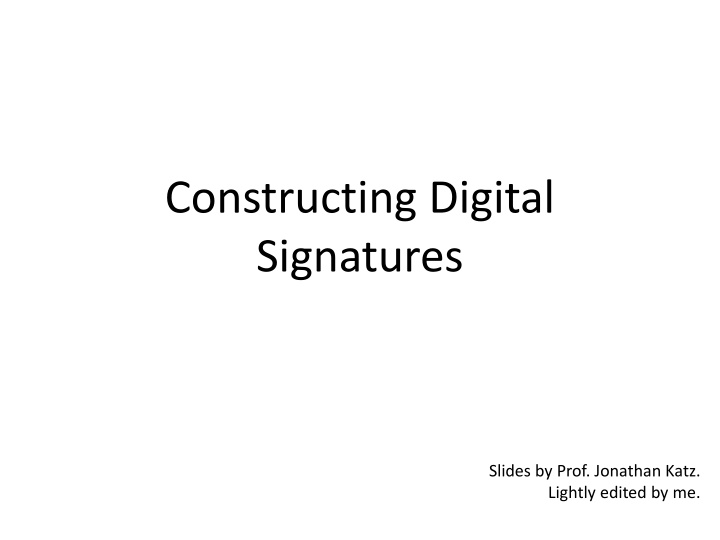
Constructing Digital Signatures with Prof. Jonathan Katz Slides
Learn the concept of constructing digital signatures presented in slides by Prof. Jonathan Katz, elaborating on the hash-and-sign paradigm, signature schemes, and practical implementations like RSA-based signatures. Explore the RSA assumption, Dlog-based signatures, and more for a comprehensive understanding.
Uploaded on | 1 Views
Download Presentation

Please find below an Image/Link to download the presentation.
The content on the website is provided AS IS for your information and personal use only. It may not be sold, licensed, or shared on other websites without obtaining consent from the author. If you encounter any issues during the download, it is possible that the publisher has removed the file from their server.
You are allowed to download the files provided on this website for personal or commercial use, subject to the condition that they are used lawfully. All files are the property of their respective owners.
The content on the website is provided AS IS for your information and personal use only. It may not be sold, licensed, or shared on other websites without obtaining consent from the author.
E N D
Presentation Transcript
Constructing Digital Signatures Slides by Prof. Jonathan Katz. Lightly edited by me.
Hash-and-sign paradigm Given A signature scheme = (Gen, Sign, Vrfy) for short messages of length n Hash function H: {0,1}* {0,1}n Construct a signature scheme =(Gen, Sign , Vrfy ) for arbitrary-length messages: Sign sk(m) = Signsk(H(m)) Vrfy pk(m, ) = Vrfypk(H(m), )
Hash-and-sign paradigm Theorem: If is secure and H is collision- resistant, then is secure Proof: Say the sender signs m1, m2, Let hi = H(mi) Attacker outputs forgery (m, ), m mi for all i Two cases: H(m) = hi for some i Collision in H! H(m) hi for all i Forgery in the underlying signature scheme
Hash-and-sign paradigm Same idea as in the hash-and-MAC paradigm Can be viewed as analogous to hybrid encryption The functionality of digital signatures at the asymptotic cost of a symmetric-key operation
Signature schemes We will discuss how to construct signature schemes for short messages Using hash-and-sign, this implies signatures for arbitrary length messages
Signature schemes in practice RSA-based signatures Can be proven secure (based on RSA assumption, in random-oracle model) Dlog-based signatures Shorter signatures, faster signing than RSA-based signatures (EC)DSA Widely used, no proof of security Schnorr Can be prove secure (based on dlog assumption, in random- oracle model)
Recall Choose random, equal-length primes p, q Compute modulus N=pq Choose e, d such that e d = 1 mod (N) The eth root of m modulo N is [md mod N] (md)e = mde = m[ed mod (N)] = m mod N RSA assumption: given N, e only, hard to compute the eth root of a uniform m *N 8
Plain RSA signatures N, e m, (N, e, d) RSAGen(1n) pk = (N, e) sk = d m = [ e mod N] ? = [md mod N]
Security? Intuition Signature of m is the eth root of m supposedly hard to compute!
Attack 1 Can sign specific messages E.g., easy to compute the eth root of m = 1, or the cube root of m = 8
Attack 2 Can generate signatures on random messages Choose arbitrary ; set m = [ e mod N]
Attack 3 Can combine two signatures to obtain a third Say 1, 2 are valid signatures on m1, m2 with respect to public key N, e Then = [ 1 2 mod N] is a valid signature on the message m = [m1 m2 mod N] ( 1 2)e = 1e 2e = m1 m2 mod N
RSA-FDH Main idea: apply a cryptographic transformation to messages before signing Public key: (N, e) private key: d Signsk(m) = H(m)d mod N H must map onto all of *N Vrfypk(m, ): output 1 iff e = H(m) mod N (This also handles long messages without additional hashing)
Intuition for security? Look at the three previous attacks Not easy to compute the ethroot of H(1), Choose , but how do you find an m such that H(m) = e mod N? Computing inverses of H should be hard H(m1) H(m2) = 1e 2e = ( 1 2)e H(m1 m2)
Security of RSA-FDH If the RSA assumption holds, and H is modeled as a random oracle (mapping onto *N), then RSA-FDH is secure In practice, H is instantiated with a (modified) cryptographic hash function Must ensure that the range of H is large enough!
RSA-FDH in practice The RSA PKCS #1 v2.1 standard includes a signature scheme inspired by RSA-FDH Essentially a randomized variant of RSA-FDH
Digital signature standard (DSS) US government standard for digital signatures DSA, based on discrete-logarithm problem in subgroup of p* ECDSA, based on elliptic-curve groups See book for details Compared to RSA-based signatures Shorter signatures and public keys (for EDCSA) Can have faster signing Slower verification
